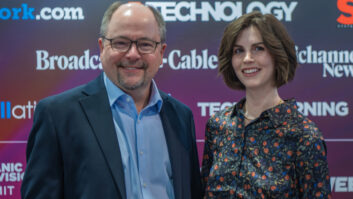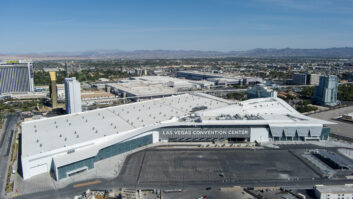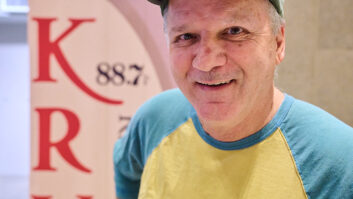Musings and mutterings, as I walked the floor of the NAB Show …
“Radio Heard Here” is the new pitch for the industry.
I was delighted to see the word “radio” on a big banner outside of the NAB convention. How many times have we begged here for more (and more aggressive) national marketing of radio?
If this really will be a “comprehensive, multidimensional, multiyear initiative” as promised by NAB, RAB and the HD Digital Radio Alliance, I’m all for it. As David Rehr put it, “The sleeping giant has awakened.” Let’s hope so.
The phrase “Radio Heard Here” tries to underscore the ubiquitous nature of our medium. However, as one executive told me in the aisles, “What does that mean, ‘Radio Heard Here’? I know I can hear radio all over the place, I’m not a Luddite. Call it ‘free radio,’ for cryin’ out loud, that’s what sets radio apart.” What exactly is the “value proposition” implied in “radio heard here,” he wonders.
(“Free” is a good alternative, though I suspect an executive sitting in a corporate radio suite doesn’t want to tie his or her hands too much by building the main pitch around “free.” Managers are always hopeful of the promise of pay services, and at least some will be drawn to the conditional access concept for that reason. But my observer dismissed that, saying conditional access didn’t work that way in other industries either.) …
* * *
The vibe on the radio equipment floor was positive. That was pleasant, given the economy and worries over the impact of major companies not exhibiting on the TV side like Apple and Avid. …
Corporate Clear Channel wasn’t there, but you saw Clear Channel people nevertheless, and CBS badges. …
What could be more affecting than a gruff man sincerely touched by emotion?
That was Tom Silliman of ERI as he talked to me of his feelings about receiving the NAB Radio Engineering Achievement Award. His eyes seemed to glow — with pride, certainly, but even more with warmth and sadness when he thought of his late father Robert, the engineer and teacher who died in 2001. How cool it would have been to have both of them up there on the podium together. …
International is where business is best these days; and manufacturer after manufacturer told me they are seeing the most activity abroad. “The dollar is the new peso,” one reiterated. China, the Middle East and the new commercial FM marketplace in India are particularly hot. …
I find myself appreciating our publisher John Casey’s foresight all the time and again at this convention.
John started pushing me seven or eight years ago for more coverage of Internet Protocol and how it would change broadcast product design. We came out with a special supplement on the topic in 2002 (plus two more since then) and have spent a great deal of space on IP-related coverage.
IP products and systems have proliferated, and you can hardly walk the convention aisles without seeing a new introduction with IP in the name …
More control and more screens is another trend in product design. Manufacturers are quick to incorporate tools to enhance the functionality of their products in today’s Internet/browser culture …
Also of note is how many features and how much power companies are packing into each product. “It’s amazing what you can get in one box for $10K,” one attendee told me. …
And how about this one: jocks playing content off their iPods into automation systems. Sure, why not? If you can’t get radio into the iPod, put the iPod into your radio station …
* * *
Rich Redmond of Harris and I chatted about radio’s traditional mindset of building its systems and business models for a 10- or 15-year life cycle and how this approach can handcuff a manager in a time of rapid technological change.
He thinks many people, or at least radio’s smartest executives, are now embracing a different approach, trying various solutions more frequently and with a different set of expectations.
These managers are more willing to experiment, to test several projects knowing that some will fail, building the cost of such attempts into their thinking at the outset. Even ideas that succeed may not remain in place for 10 or 20 years, but rather for two or three before it’s time to try something different.
I think we see this in the many online and new media initiatives that radio companies now explore regularly, and it’s an insightful discussion with implications for how RF and studio plants will be constructed in the future.
Also proliferating are video services and other products intended to help radio stations populate their visual channels. Plenty more of that on the way. …
* * *
Expect more emphasis from the Society of Broadcast Engineers on training, thanks to a new series of “online, on-demand” courses coming soon.
An early goal of this content is to help IT-savvy radio employees get up to speed on RF.
Such training is a super fit for the SBE. Cris Alexander of Crawford Broadcasting, who contributes to RW, is among those playing a leading role in making that happen. …
I was also pleased by the news (which RW first reported) that the SBE will phase out of providing frequency coordination to the NFL. SBE did the right thing by setting that relationship up, and it’s doing the right thing now by recognizing that the arrangement has grown to the point where the football industry can afford to hire frequency coordinators. …
Are any FM IBOC stations cranking their digital signals up by 10 dB, not waiting for regulatory action? We hear that it’s happening in some instances, confident that the commission won’t respond. What are the consequences if it is happening?
(Then again, one processing expert says bluntly, some stations regularly run 140 percent modulation.) …
* * *
Kudos to NAB planners for a small, but helpful touch: giving out badge lanyards with clamps on two ends of the string rather than one. That avoids the nagging problem of badges flipping over. …
Bigger thanks are due to the NAB for getting four transmitter manufacturers and Ibiquity together to help bring down the cost of HD Radio infrastructure through their embedded exporter announcement.
HD-R is still an expensive proposition for many stations but this is the kind of cooperation we want and should expect from our industry’s leaders. …
As I walk the floor I find myself more optimistic than I’ve been in some time about digital radio. Stepping back from debate over timetables and rollouts, what I see is that the industry is succeeding at building an infrastructure. Those with HD plants will now begin to put them to use in powerful new ways.
The combined effect of new services and proliferation of portable devices will start to tell. Within a year I believe we’ll see a stronger business model for HD Radio that will encourage more stations to adopt it, and the rollout will resume vigorously. …
I also like what Bob Pittman, formerly of MTV Networks and AOL, had to say about radio: “It’s frustrating for me … to hear people talk about radio as if there’s something wrong with the business. In my mind, when you look at radio, you’re looking at the future. All you have to do is look at the consumer.” He says consumers treasure convenience and branding, two core strengths of radio. …
Tim Robbins certainly made an impact in Vegas. The actor/activist had plenty to say about broadcasters’ responsibility in our culture. Reaction online was all over the place: was it “a profanity laced-tirade from a left-wing kook” or “a keynote speech laced with wry irony and winking sarcasm,” or “a brilliant speech” or “a little windy, but it’s pretty amazing somebody said this to a NAB audience.”
One NAB official told me in private, “I promise you, that’s the first time anyone has spoken the word c***s***** from the NAB podium.” …
But my favorite moment of the show took place away from the LVCC.
I was out for a dawn run along the Strip, dodging drunks and hookers, listening to the casino audio systems blaring their nonstop messages of consumerism to empty sidewalks.
As I ran under the marquee of Planet Hollywood, the sound system blared “Big Yellow Taxi”:
“They paved paradise and put up a parking lot, with a pink hotel, a boutique and a swinging hot spot. Don’t it always seem to go that you don’t know what you’ve got till it’s gone? They paved paradise and put up a parking lot.”
* * *
Radio World saluted our friend and colleague Dale Tucker with a champagne toast to his service to the industry and 17 years with the company as our regional sales manager.
Founder and former owner Steve Dana, a resident of Las Vegas, took part along with Publisher John Casey, shown in the RW booth at left. During the ham reception, Sarah and Bob Heil, right, warmly congratulated Dale.
“I got into radio while working in the toy department at Higbee’s department store in downtown Cleveland,” he told me. “I was a radio junkie and recognized the voices of many local radio personalities as they were Christmas shopping for toys.
“I met Bill Jorgenson in 1960 when he was the primary newsman at WERE Radio in Cleveland. I recognized his voice and after a few minutes asked how I could ‘get into radio.’”
Jorgenson took him aside and told him to apply at small-market Ohio stations. “He pulled out the Broadcasting Yearbook and circled the info, which I copied. One station I contacted invited me down for an audition. I was a complete and scared-to-death rookie but was hired at WILE, Cambridge as a staff announcer.”
Dale Tucker has worked been in management and programming at several stations including KSPN(FM) in Aspen, KOA(AM) in Denver and WRKO(FM) in Boston, among others. He also worked in manufacturing sales for Broadcast Audio and Cetec Broadcast, and for Radio Resources, David Green and Pulse of Broadcasting.
A classy guy and a true friend to radio.












